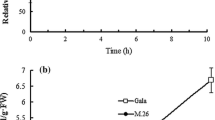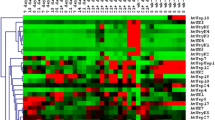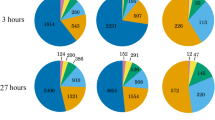Abstract
The genes expressed within an organism determine its biological characteristics. Various internal or external factors can modulate these gene expression patterns, which then elicit physiological or pathological changes. We have characterized the global gene expression patterns of Arabidopsis leaves by serial analysis of gene expression (SAGE). A total of 21 280 SAGE tags were sequenced and 12 049 unique tags were identified. Among these, only 3367 tags (27.9%) were matched to the Arabidopsis cDNA or EST database. Functional analysis of annotated tags indicated that a significant proportion of the genes expressed in normal leaves were involved in energy and metabolism, especially in photosynthesis. To systematically analyze differential gene expression profiles under cold stress, a similar SAGE tag library from cold-treated leaves was constructed and analyzed. A comparison of the tags derived from the cold-treated leaves with those identified in the normal leaves revealed 272 differentially expressed genes (P<0.01): 82 genes were highly expressed in the normal leaves and 190 genes were highly expressed in the cold-treated leaves. After cold stress, in general, many of the genes involved in cell rescue/defense/cell death/aging, protein synthesis, metabolism, transport facilitation, and protein destination were induced. They included various COR genes, lipid transfer protein genes, alcohol dehydrogenase, β-amylase and many novel genes. By comparison, down-regulated genes were mostly photosynthesis related genes involved in energy metabolism. The expression patterns of several cold responsive transcripts identified by SAGE were confirmed by northern analysis. The results presented here will provide valuable information for understanding the mechanisms of the freezing tolerance of plants.
Similar content being viewed by others
References
Arabidopsis Genome Initiative. 2000. Analysis of the genome sequence of the flowering plant Arabidopsis thaliana. Nature 408: 796-815.
Aufsatz, W. and Grimm, C. 1994. A new, pathogen-inducible gene of Arabidopsis is expressed in an ecotype-specific manner. Plant Mol. Biol. 25: 229-239.
Cushman, J.C. and Bohnert, H.J. 2000. Genomic approaches to plant stress tolerance. Curr. Opin. Plant Biol. 3: 117-124.
Danyluk, J., Perron, A., Houde, M., Limin, A., Fowler, B., Benhamou, N. and Sarhan, F. 1998. Accumulation of an acidic dehydrin in the vicinity of the plasma membrane during cold acclimation of wheat. Plant Cell 10: 623-638.
Donson, J., Fang, Y., Espiritu-Santo, G., Xing, W., Salazar, A., Miyamoto, S., Armendarez, V. and Volkmuth, W. 2002. Comprehensive gene expression analysis by transcript profiling. Plant Mol. Biol. 48: 75-97.
Douce, R. and Neuburger, M. 1999. Biochemical dissection of photorespiration. Curr. Opin. Plant Biol. 2: 214-222.
Epand, R.M., Shai, Y., Segrest, J.P. and Anantharamaiah, G.M. 1995. Mechanisms for the modulation of membrane bilayer properties by amphipathic helical peptides. Biopolymers 37: 319-338.
Fowler, S. and Thomashow, M.F. 2002. Arabidopsis transcriptome profiling indicates that multiple regulatory pathways are activated during cold acclimation in addition to the CBF cold response pathway. Plant Cell 14: 1675-1690.
Gilmour, S.J., Zarka, D.G., Stockinger, E.J., Salazar, M.P., Houghton, J.M. and Thomashow, M.F. 1998. Low temperature regulation of the Arabidopsis CBF family of AP2 transcriptional activators as an early step in cold-induced COR gene expression. Plant J. 16: 433-442.
Guy, C. 1990. Cold acclimation and freezing stress tolerance: role of protein metabolism. Annu. Rev. Plant Physiol. Plant Mol. Biol. 41: 187-223.
Holmberg, N. and Bulow, L. 1998. Improving stress tolerance in plants by gene transfer. Trends Plant Sci. 3: 61-66.
Hon, W.C., Griffith, M., Mlynarz, A., Kwok, Y.C. and Yang, D.S. 1995. Antifreeze proteins in winter rye are similar to pathogenesis-related proteins. Plant Physiol. 109: 879-889.
Kamalay, J.C. and Goldberg, R.B. 1980. Regulation of structural gene expression in tobacco. Cell 19: 935-946.
Kim, J.C., Lee, S.H., Cheong, Y.H., Yoo, C.M., Lee, S.I., Chun, H.J., Yun, D.J., Hong, J.C., Lee, S.Y., Lim, C.O. and Cho, M.J. 2001. A novel cold-inducible zinc finger protein from soybean, SCOF-1, enhances cold tolerance in transgenic plants. Plant J 25: 247-259.
Kiper, M., Bartels, D., Herzfeld, F. and Richter, G. 1979. The expression of a plant genome in hnRNA and mRNA. Nucl. Acids Res 6: 1961-1978.
Lin, C. and Thomashow, M.F. 1992. DNA sequence analysis of a complementary DNA for cold-regulated Arabidopsis gene cor15 and characterization of COR15 polypeptide. Plant Physiol. 99: 519-526.
Mascarenhas, J.P. 1989. The male gametophyte of flowering plants. Plant Cell 1: 657-664.
Park, A.R., Cho, S.K., Yun, U.J., Jin, M.Y., Lee, S.H., Sachetto-Martins, G. and Park, O.K. 2001. Interaction of the Arabidopsis receptor protein kinase Wak1 with a glycine-rich protein, AtGRP-3. J. Biol. Chem. 276: 26688-26693.
Nylander, M., Svensson, J., Palva, E.T. and Welin, B.V. 2001. Stress-induced accumulation and tissue-specific localization of dehydrins in Arabidopsis thaliana. Plant Mol. Biol. 45: 263-279.
Sachetto-Martins, G., Franco, L.O. and de Oliveira, D.E. 2000. Plant glycine-rich proteins: a family or just proteins with a common motif? Biochim. Biophys. Acta 1492: 1-14.
Sakamoto, H., Araki, T., Meshi, T. and Iwabuchi, M. 2000. Expression of a subset of the Arabidopsis Cys(2)/His(2)-type zinc-finger protein gene family under water stress. Gene 248: 23-32.
Seki, M., Narusaka, M., Abe, H., Kasuga, M., Yamaguchi-Shinozaki, K., Carninci, P., Hayashizaki, Y. and Shinozaki, K. 2001. Monitoring the expression pattern of 1300 Arabidopsis genes under drought and cold stresses by using a full-length cDNA microarray. Plant Cell 13: 61-72.
Seki, M., Narusaka, M., Ishida, J., Nanjo, T., Fujita, M., Oono, Y., Kamiya, A., Nakajima, M., Enju, A., Sakurai, T., Satou, M., Akiyama, K., Taji, T., Yamaguchi-Shinozaki, K., Carninci, P., Kawai, J., Hayashizaki, Y. and Shinozaki, K. 2002a. Monitoring the expression profiles of 7000 Arabidopsis genes under drought, cold and high-salinity stresses using a full-length cDNA microarray. Plant J. 31: 279-292.
Seki, M., Narusaka, M., Kamiya, A., Ishida, J., Satou, M., Sakurai, T., Nakajima, M., Enju, A., Akiyama, K., Oono, Y., Muramatsu, M., Hayashizaki, Y., Kawai, J., Carninci, P., Itoh, M., Ishii, Y., Arakawa, T., Shibata, K., Shinagawa, A. and Shinozaki, K. 2002b. Functional annotation of a full-length Arabidopsis cDNA collection. Science 296: 141-145.
Shinozaki, K. and Yamaguchi-Shinozaki, K. 1996. Molecular responses to drought and cold stress. Curr. Opin. Biotechnol. 7: 161-167.
Stockinger, E.J., Gilmour, S.J. and Thomashow, M.F. 1997. Arabidopsis thaliana CBF1 encodes an AP2 domain-containing transcriptional activator that binds to the C-repeat/DRE, a cisacting DNA regulatory element that stimulates transcription in response to low temperature and water deficit. Proc. Natl. Acad. Sci. USA 94: 1035-1040.
Strauss, G. and Hauser, H. 1986. Stabilization of lipid bilayer vesicles by sucrose during freezing. Proc. Natl. Acad. Sci. USA 83: 2422-2426.
Thomashow, M.F. 1998. Role of cold-responsive genes in plant freezing tolerance. Plant Physiol. 118: 1-8.
Thomashow, M.F. 1999. Plant cold acclimation: freezing tolerance genes and regulatory mechanisms. Annu. Rev. Plant Physiol. Plant Mol. Biol. 50: 571-599.
Todaka, D., Matsushima, H. and Morohashi, Y. 2000. Water stress enhances Qβ-amylase activity in cucumber cotyledons. J. Exp. Bot. 51: 739-745.
Uemura, M. and Steponkus, P.L. 1997. Effect of cold acclimation on membrane lipid composition and freeze-induced membrane destabilization. In: Plant Cold Hardness: Molecular Biology, Biochemistry and Physiology, pp. 171-179.
Velculescu, V.E., Zhang, L., Vogelstein, B. and Kinzler, K.W. 1995. Serial analysis of gene expression. Science 270: 484-487.
Velculescu, V.E., Zhang, L., Zhou, W., Vogelstein, J., Basrai, M.A., Bassett, D.E., Jr., Hieter, P., Vogelstein, B. and Kinzler, K.W. 1997. Characterization of the yeast transcriptome. Cell 88: 243-251.
Xin, Z. and Browse, J. 2000. Cold comfort farm: the acclimation of plants to freezing temperatures. Plant Cell Environ. 23: 893-902.
Author information
Authors and Affiliations
Rights and permissions
About this article
Cite this article
Jung, SH., Lee, JY. & Lee, DH. Use of SAGE technology to reveal changes in gene expression in Arabidopsis leaves undergoing cold stress. Plant Mol Biol 52, 553–567 (2003). https://doi.org/10.1023/A:1024866716987
Issue Date:
DOI: https://doi.org/10.1023/A:1024866716987




